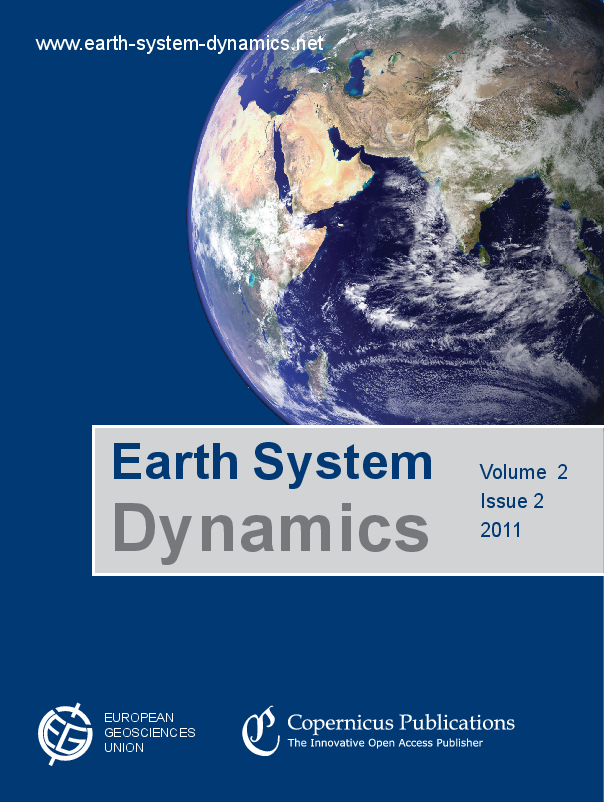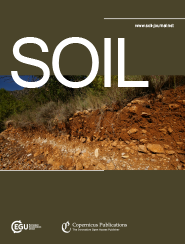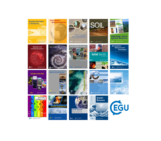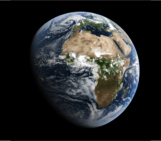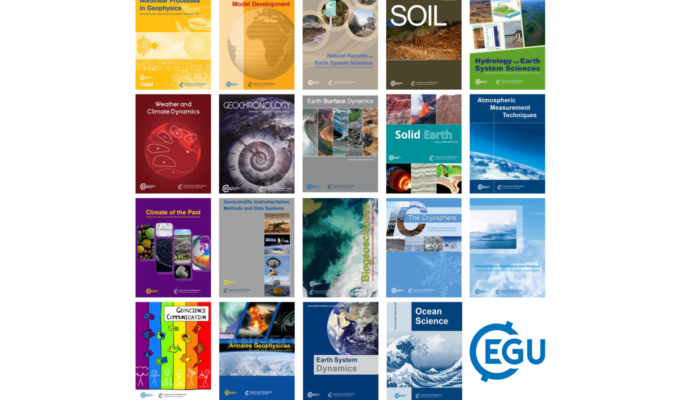
Each month we feature specific Divisions of EGU and during the monthly GeoRoundup we put the journals that publish science from those Divisions at the top of the Highlights section. During this month, we are featuring Energy, Resources and the Environment (ERE) and Hydrological Sciences (HS). They are represented by the journals Geoscientific Model Development (GMD), Solid Earth (SE), Earth System Dynamics (ESD), and Hydrology and Earth System Sciences (HESS)
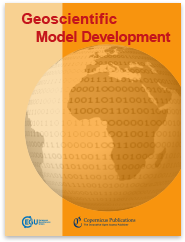 Geoscientific Model Development
Geoscientific Model Development
nextGEMS: entering the era of kilometer-scale Earth system modeling – 23 October 2025
The Next Generation of Earth Modeling Systems project (nextGEMS) developed two Earth system models that use horizontal grid spacing of 10 km and finer, giving more fidelity to the representation of local phenomena, globally. In its fourth cycle, nextGEMS simulated the Earth System climate over the 2020–2049 period under the SSP3-7.0 scenario. Here, we provide an overview of nextGEMS, insights into the model development, and the realism of multi-decadal, kilometer-scale simulations.
A dilatant visco-elasto-viscoplasticity model with globally continuous tensile cap: stable two-field mixed formulation – 10 October 2025
We present a simple plasticity model that can be used for robust modeling of strain localization in both shear and tensile failure regimes. The new model overcomes the difficulty related to combining these regimes and enables for particularly simple and reliable numerical implementation, which delivers regularized solutions that are insensitive to mesh resolution. We describe algorithmic details and demonstrate the applications to a number of relevant strain localization problems.
AR6 updates to RF by GHGs and aerosols lowers the probability of accomplishing the Paris Agreement compared to AR5 formulations – 16 October 2025
We show that recent assessed updates to the future abundance and radiative forcing (RF) of greenhouse gases (GHGs) and tropospheric aerosols result in a 0.2 to 0.4 ⁰C rise in global mean surface temperature by the end of the century, relative to prior projections. For society to have confidence in achieving the 2 ⁰C warming limit of the Paris Agreement, the RF due to GHGs and aerosols must be placed close to the primary 2.6 W m−2 Shared Socioeconomic Pathway scenario (SSP1−2.6) over the coming decades.
Tipping points in ocean and atmosphere circulation – 08 October 2025
In this work, we draw on palaeo-records, observations, and modelling studies to review tipping points in the ocean overturning circulations, monsoon systems, and global atmospheric circulations. We find indications for tipping in the ocean overturning circulations and the West African monsoon, with potentially severe impacts on the Earth system and humans. Tipping in the other considered systems is regarded as conceivable but is currently not sufficiently supported by evidence
Increased future ocean heat uptake constrained by Antarctic sea ice extent – 02 October 2025
Representing soil landscapes from digital soil mapping products – helping the map to speak for itself – 21 October 2025
Soil maps are useful for many applications, e.g., hydrology, agriculture, ecology, and civil engineering. The dominant mapping method is Digital Soil Mapping (DSM), which uses training observations and machine-learning to predict per-pixel. Accuracy is assessed by statistical evaluation at known points, but soils occur in spatial patterns. We present methods for helping the map to “speak for itself” to reveal patterns of the soil landscape.
Properties of large-amplitude kilometer-scale field-aligned currents at auroral latitudes, as derived from Swarm satellites – 29 October 2025
Effects of geomagnetic mirror force and pitch angles of precipitating electrons on ionization of the polar upper atmosphere – 20 October 2025
Atmospheric Chemistry and Physics
Review of interactive open-access publishing with community-based open peer review for improved scientific discourse and quality assurance – 28 October 2025
The role of the tropical carbon balance in determining the large atmospheric CO2 growth rate in 2023 – 21 October 2025
MOSAiC studies of long-lasting mixed-phase cloud events and analysis of the liquid-phase properties of Arctic clouds – 20 October 2025
A tracer study for the development of in-water monitoring, reporting, and verification (MRV) of ship-based ocean alkalinity enhancement – 10 October 2025
Extensive fire-driven degradation in 2024 marks worst Amazon forest disturbance in over 2 decades – 08 October 2025
Place-based science from Okinawa: 18th-century climate and geology recorded in Ryukyuan classical music – 07 October 2025
Visualising historical changes in air pollution with the Air Quality Stripes – 01 October 2025
Geoscientific Instrumentation, Methods and Data Systems
Mapping the safe operating space of marine ecosystems under contrasting emission pathways – 09 October 2025
Natural Hazards and Earth System Sciences
Insights from hailstorm track analysis in European climate change simulations – 01 October 2025
Thwaites Eastern Ice Shelf cavity observations reveal multiyear sea ice dynamics and deepwater warming in Pine Island Bay, West Antarctica – 28 October 2025
Insights into mesoscale eddy dynamics: a three-dimensional perspective on potential density anomalies – 20 October 2025
The coupled oxygen and carbon dynamics in the subsurface waters of the Gulf and Lower St. Lawrence Estuary and implications for artificial oxygenation – 02 October 2025
Formation of mega-scale glacial lineations far inland beneath the onset of the Northeast Greenland Ice Stream– 30 October 2025
TICOI: an operational Python package to generate regular glacier velocity time series – 15 October 2025
Estimating return periods for extreme events in climate models through Ensemble Boosting – 21 October 2025
EGU in the news – October
- Heidi Kreibich, President of the Natural Hazards Division, is the new head of the GFZ Hydrology Section
- EGU honours Kai Kornhuber with Top Climate Division Early Career Scientist Award
- Coral reefs at ‘Tipping Point,’ but EGU study urges precaution on definitive thresholds
- Transparent peer review: Nature Geoscience joins EGU journals in publishing author-reviewer exchanges
- Shocking EGU Study: Antarctic dynamics point to ‘hotter, faster future’ and higher sea level rise

